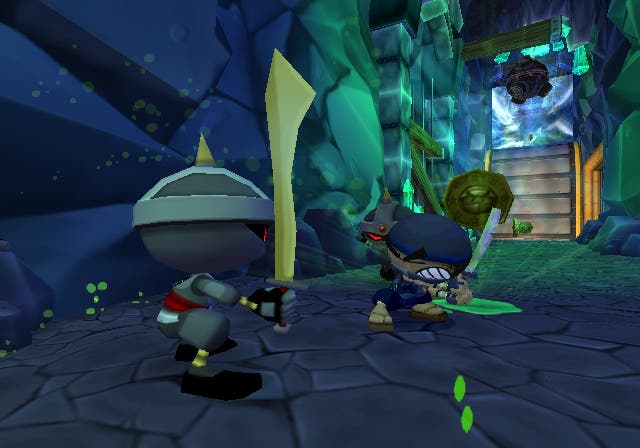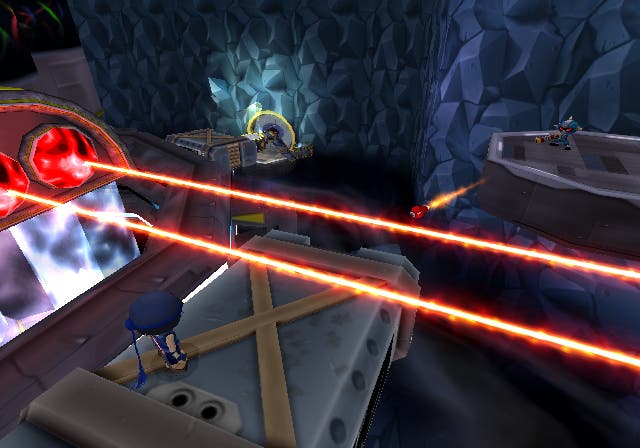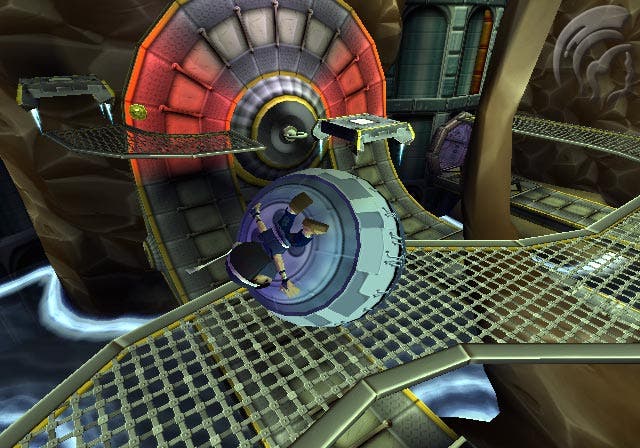I-Ninja
Argonaut's best game in ages.
The PS2 is hardly suffering a platform game shortage. Over the past few months alone we've seen the release of Jak II: Renegade, Ratchet & Clank 2 and Prince of Persia, all of which raised the bar in different areas, and all of which any self-respecting fan of the genre either owns, or has marked down on their shopping list just above toilet paper and Doritos. Looking further back, there are plenty of other, equally indispensable platformers available on the system, some of which have even made it onto the budget PS2 Platinum label, removing yet more of the barriers to purchase. Quite frankly, there's a feeling around here that any newcomer hoping to compete would need to offer more impressive tech and visuals, license attachment of some description, or something genuinely new and innovative in order to catch our attention. Then again, it's nice to be proved wrong once in a while...
Rage against the machine

Not only does I-Ninja fail to match the above-mentioned titles visually or mechanically, but moments of innovation are few and far between, and yet this is a game I've spent hours and hours playing in my own time, despite a growing pile of really exceptional games bought in the January sales that I really need to get round to trying out before publishers wake up and start releasing games again. Developed by UK-based Argonaut, it's a basic-looking 3D platformer with super-deformed characters, which riffs on everything from Ratchet & Clank and Sonic Adventure to Super Monkey Ball and Super Punch Out in an effort to keep you happy. The story is more or less irrelevant; the central Ninja character is about as far removed from the silent assassins prevalent in other ninja titles as you can imagine; and it's full of backtracking and an over-abundance of collectibles. It even has some static shoot-'em-up sections. Why the hell do I like it exactly?
Well, for a start it doesn't take itself seriously and it's got a good sense of humour. The very first thing you'll see when you first load the game is our bigheaded warrior lashing his sword at the massed ranks of robotic enemies, yelping "hoo", "ha!" and all sorts of other nonsense noises that no self... aware martial artist would ever be caught dead screaming at an adversary. Not content with that, the opening cut sequence sees our sprightly hero accidentally brutally decapitate his former sensei, who quickly returns in ghostly form to guide him through the game's many challenges - on the way to derailing the machinations of the evil O-Dor. (See, I told you it was a load of crap!) Throughout the rest of the game, Ninja (for that is his name) only opens his mouth to offer wisecracks and taunts, like "Try not to die again!" and, for his part, the venerable sensei fights back by offering disjointed pearls of wisdom like "a stitch in time is worth... two in the bush".
A sworded affair

Fortunately though your sensei's muddled ramblings aren't all that important (so you can feel quite content hitting X to literally "Shh!" him whenever he starts blathering), because I-Ninja is an archetypal third-person platform game, with a mostly obedient camera system mapped to the right analogue stick, movement on the left, jump and double jump on X, slash and downward thrust moves on square and triangle, and all manner of other tricks and feats that you're probably familiar with lined up elsewhere. You can expect slash-'em-up combat with combination moves, shuriken and dart-throwing, Sonic Adventure-style looping rollercoaster chases (using a chain for leverage round corners when prompted), hovering using the blade as a chopper, running up walls and using the sword to reach the top, running along walls like a certain Prince (though hardly with the level of freedom afforded in Prince of Persia), triangle jumping between adjacent walls, grappling with a hook and even running back and forward to build up momentum and climb up the inside of a half-pipe. Neat.
And it's by no means a shambolic affair, despite the vast number of things Ninja can do in any given level. Thanks to some intelligent control mapping, everything comes fairly naturally, and the only things you'll have to worry about are the format of the level if it's your average platform offering (some of which emphasise combat, some speed, some precision jumping, some peripheral skills like piloting RC rockets, and some of which demand a little stealth), or completing a brief tutorial before each boss fight. The other key factor in avoiding confusion is the signposting, which strikes the right balance between the subtle and the blazingly obvious, guiding you into each new move without beating you around the head with a stupid stick (which is a problem in February rival Sonic Heroes, in my experience).
Argonaut hasn't been afraid to vary the pace, either, introducing a Monkey Ball/Marble Madness inspired sub-game early on, which involves Ninja rolling a series of robotic components through mazy levels full of narrow or moving platforms and obstacles, and coming back to it several times elsewhere in the game. Boss encounters too add some varierty, with a necessary brief tutorial prior to each underscoring the difference in style. The first of these, for example, is a first-person boxing match, and it's easily one of the most memorable moments in the game - partly because it's well executed, and partly because it's completely unexpected.
Play it again

On the whole, then, it's nothing particularly unusual, it's just very competently put together. The quest for the rage stones (which originally infused Ninja with his sensei-head-lopping psychosis) takes the player through several themed areas, in which Ninja finds half a dozen or so levels to overcome including a final boss encounter. With each boss conquered, our hero gathers another rage ability, unleashed by pressing a particular directional pad button when the rage meter is full - cue blinding sword displays, a rejuvenated health meter, and other helpful benefits. You're also forced to make tactical decisions based on the rage meter too, because once you've used a particular power, the meter has to recharge again - bad news if you then encounter the rather scary swordsman who fights you several times on a twirling starscape high above the ground, tumbling smashed and broken back to earth with a squelch when you reel off your furious rage stone-powered attacks and vanquish him. Or beating the crap out of you if you're not otherwise at your sharpest.
It is possible, however, to surmise that Argonaut had difficulty giving I-Ninja the legs that other platform games enjoyed - particularly the pretty sprawling Jak and Ratchet titles of last Christmas. Played through without pausing to take on the bonus "Ninja Ball" levels, or without being forced to replay previous levels, and the game would probably fall in around six or seven hours - thanks in no small part to a generous save system. But thanks to a system of belts (Ninjas compete for karate belts?), you can only access certain levels when you've amassed a decent number of ranks - tokens collected at the conquering of any given task. You might wonder where the branching is in each level to justify this replay - after all, it was extremely obvious in Ratchet & Clank - but the truth is there is no branching. Playing the same level again to earn another rank, you may be expected to work against a time limit, or gather eight red coins ala Mario, but you'll still be facing the same level.
And yet like so many other elements of I-Ninja, this contrived system of forced replay value slides past attracting only the slightest hint of my wrath. For some reason, most of the levels in I-Ninja are easy enough to stomach several times over, and it's only very occasionally that you load up a task and think, "Oh well, at least it'll be over in a few minutes." As somebody who has scoured many a platform game for hidden extras over the years, I can tell you that's a pretty impressive feat, and it owes something to the game's gentle difficulty curve, too.
Vincent van Ninja

That said, the game is a little less impressive on the technical front. Fortunately though it's not trying to outdo the likes of Jak II and Prince of Persia visually speaking, and that actually works in its favour. Super-deformed characters (think Bomberman) work well with the bright, cheery aesthetic. Texturing and geometric design is often quite minimalist, but it paints a nice cartoony picture, and environments don't recycle visuals too much either (although there are some areas that go on a bit too long, like one particular jungle outing full of totem poles).
The minimalist look also means that I-Ninja can surprise you occasionally with impressive effects and little flourishes of animation. The recurring rock/cliffside texture is just a simple mesh of big seamless triangles forming a rocky wall, but the careful shading and shadowing gives it a sort of solidity missing from some titles. Meanwhile, Ninja himself is a master of delicate sword moves, like his backward stab, and although enemy innards are green rather than red it's still pretty impressive to see a cleaved foe peel apart as Ninja sheathes his katana. Don't sit around gawping too long though or he'll start cracking his knuckles or assuming the mantis position.
Aurally the game does less well than the graphic artists, with Ninja's voice in particular due a couple of question marks. The poor fellow can't seem to decide whether he's a kid or a grown-up, and it's also a shame that he hasn't got more things to say when dispatching enemies. Nevertheless, it's worth keeping the volume turned up for his now-ghostly sensei's attempted proverbs, not to mention all the "hiyaa!"-ing and whatnot. And don't worry, the broad mix of backing tracks don't become too annoying.
Argonauty Dog
It's easy to look at the screenshots and hear the premise and wonder why you should give a damn about I-Ninja. (Hell, I could barely work it out when I was completely intoxicated by it all.) But against all the odds it's managed to take elements of loads of popular platform games and culture a healthy mix, varied throughout and consistently entertaining, even if it isn't particularly original or exceptional in any one area. It may not be the next Mario 64 or Jak & Daxter, but it's a strong game, and well worth considering if you've already polished off Naughty Dog and Insomniac's latest offerings.
If there is a significant criticism to be made here, it is the more objective view that I-Ninja lacks many truly memorable moments (the aforementioned boxing match excluded). Experienced platform fans will recognise its tricks before they even hit, and they may feel mildly short-changed for it, even if I have a strong suspicion they'll be as happy playing it as I have been. Given that this is fresh intellectual property for Argonaut, we'd expect to see another chapter in the I-Ninja tale before too long, and if it does produce a sequel then we should all hope for more of the Argonaut team's own ideas and less of the admittedly well-presented ideas borrowed from elsewhere. It's pretty clear from this that they're worth keeping an eye on.

